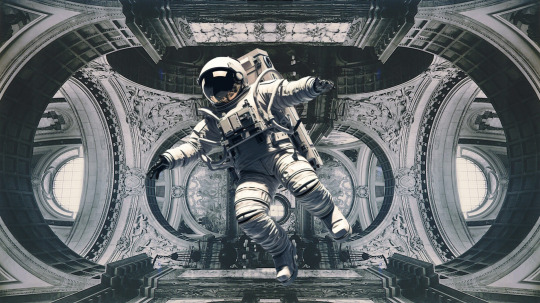#SpatialParadigm
Explore tagged Tumblr posts
Text

Gravity's Embrace: Exploring Classical Architecture's Cosmic Connection and the Quest for a New Spatial Paradigm
Classical architectural space, rooted in principles developed over centuries, is indeed deeply intertwined with the laws of nature. These principles often reflect human experiences, cultural values, and an understanding of the physical world. Classical architecture draws heavily from geometry, proportion, and symmetry, all of which resonate with natural patterns and forms. For instance, the use of the golden ratio in classical architecture mirrors the proportions found in nature, from the arrangement of petals in a flower to the spiral of a seashell.
Furthermore, classical architecture often seeks to harmonize with its surroundings, whether it's integrating with the landscape or aligning with celestial phenomena like the path of the sun or the positions of stars. This integration reflects an acknowledgment of humanity's place within the broader cosmos.
If architecture were to defy gravity, it would necessitate a radical reimagining of classical principles. Gravity is not just a force we contend with; it's a fundamental aspect of our experience of space and the built environment. Without gravity, structures would lack stability and orientation as we understand them. Therefore, a new architecture would need to emerge—one that doesn't rely on traditional supports and spatial relationships.
This new architecture would likely draw inspiration from the microgravity environments experienced in space, where traditional notions of up and down lose their meaning. Designers might explore structures that float or orbit, embracing a more fluid and dynamic conception of space. Rather than grounding buildings to the earth, they might anchor them to celestial bodies or design them to move in harmony with cosmic forces.
In honouring space both architecturally and cosmically, designers would need to consider not only the physical laws that govern our universe but also the deeper connections between humanity and the cosmos. Architecture would become a means of exploring our cosmic predicament as inhabitants of Earth, reminding us of our place in the vastness of space and our responsibilities as stewards of our planet. This new architecture would not just defy gravity but transcend it, offering a glimpse of a future where humanity's relationship with the cosmos is reflected in every facet of our built environment.
#GravitysEmbrace#ClassicalArchitecture#CosmicConnection#SpatialParadigm#NewArchitecture#CosmicExploration#DesignInnovation#NatureInspired#HarmonyWithTheCosmos#architecture#berlin#area#london#acme#chicago#puzzle#edwin lutyens#massimoscolari#oma
0 notes